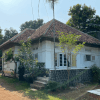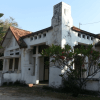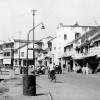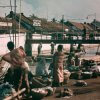
One of the largest and most beautifully designed houses of architect P.A.J. Moojen in Kramat was the one on Kramatlaan 24 (now Jalan Kramat V 24). It was at the end of the street, close to the Ciliwung River, and together with the house on the opposite side of the road (Kramatlaan 15, also known as the “Haunted House”, see our previous post), it had the largest plot of land. When seated in the spacious garden, residents of this house were able to hear the calming sound of the nearby river. Most of these houses were inhabited by influential Batavia/Jakarta residents at the time, of which a few were members of the Raad van Indië (Council of the Indies).
Herman Salomonson
Between 1923 and 1926 this house on Kramatlaan 24 was the residence of Herman Salomonson (1892-1942), also known under his pseudonym Melis Stoke. Salomonson was a dynamic personality, novelist and editor-in-chief of newspaper Java Bode. He also wrote rhyming chronicles, published in the papers at the time, and this made him a household name in the Dutch East Indies during the mid 1920s. Salomonson left Batavia in 1926 after the founder of news agency Aneta, Dominique Berretty (1890-1934) had asked him to become the director of Aneta’s branch in The Hague.
World War II
The events of World War II sadly cut his life short. Herman Salomonson, a Jew, was murdered by the Germans in 1942. The photo shows Herman Salomonson and his family in better times, relaxing in the garden with the majestic Moojen house at the back. Part of this house still stands today (see the photo in the comment section) but it has been severely altered and despite some characteristic Moojen elements left, the house has lost all of its former grandeur.
source: Gerard Termorshuizen, “A humane colonial, life and work of Herman Salomonson, a.k.a. Melis Stoke”, Amsterdam 2015





